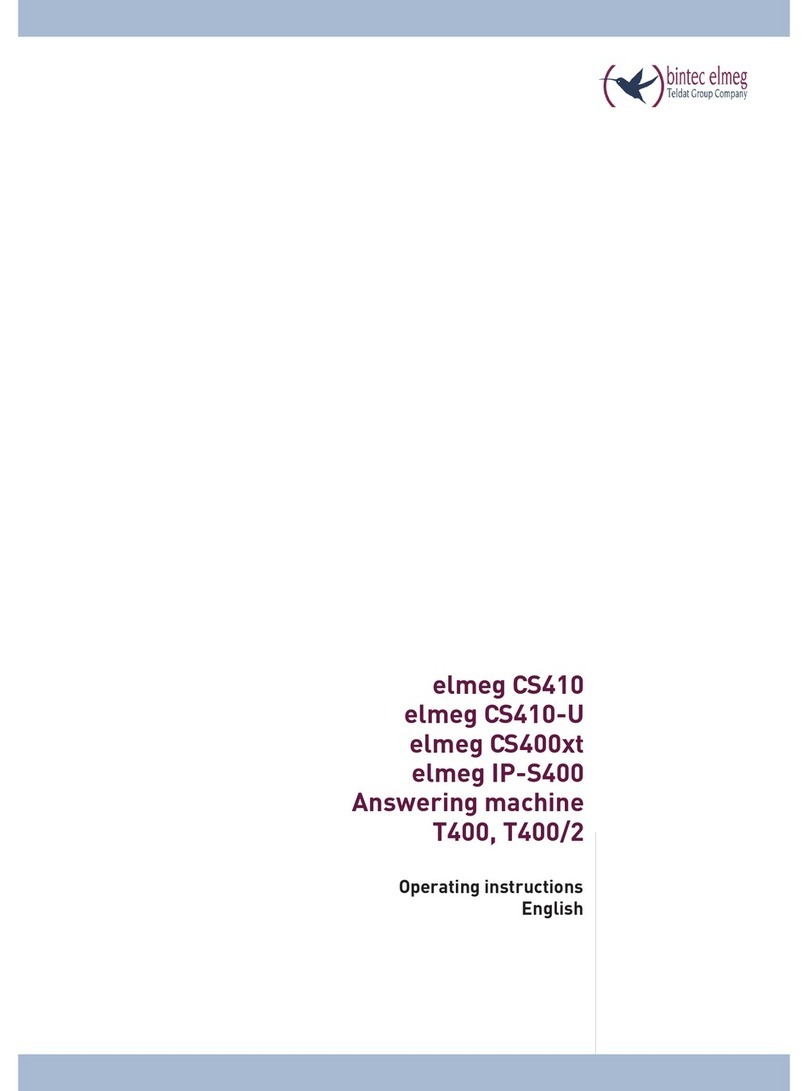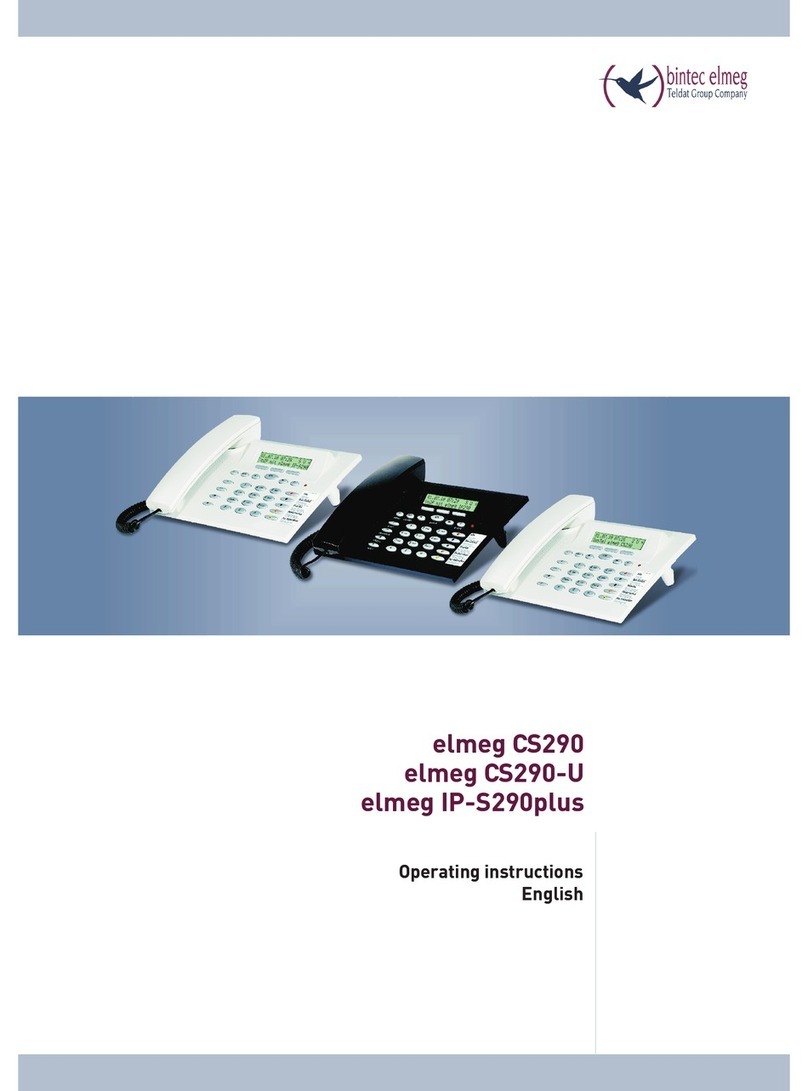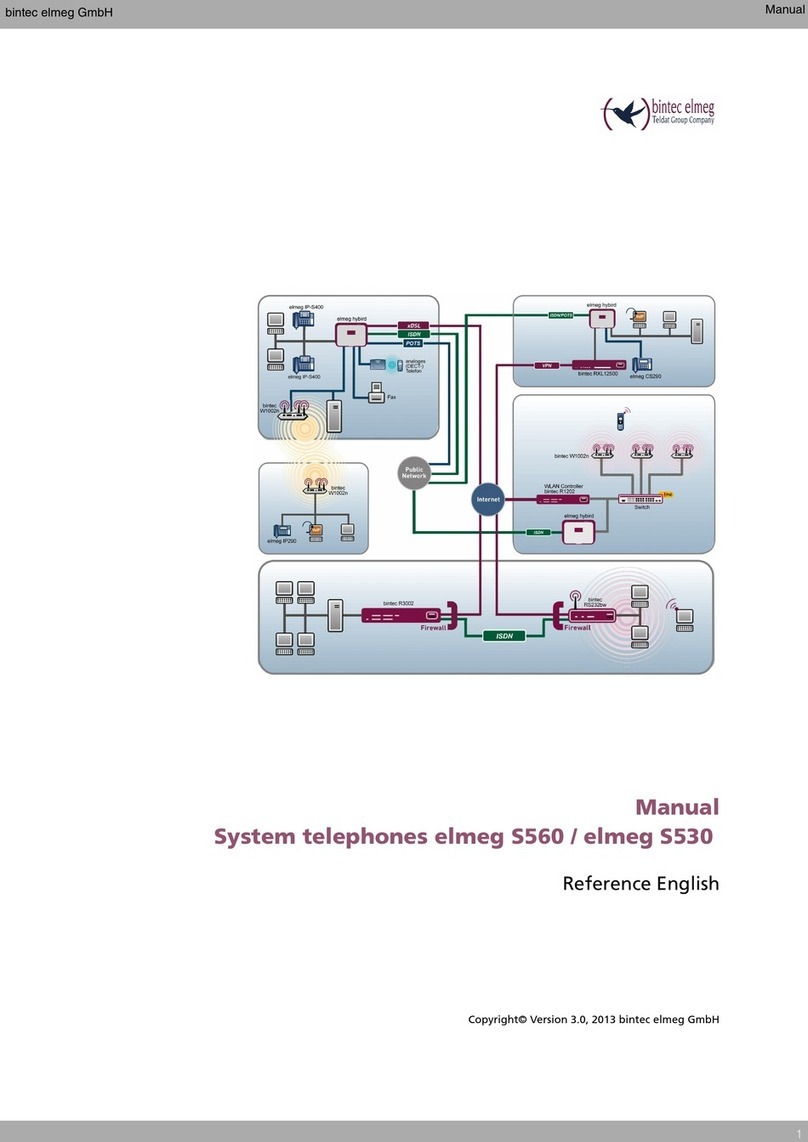BinTec elmeg T444 User manual

elmeg T444
Operating instructions
English

Declaration of conformity and CE marks
This device meets the requirements of the following EC directive R&TTE 6/3/EG:
»Directive 1999/5/EC of the European Parliament and of the Council of 9 March 1999 on radio equip-
mentandtelecommunicationsterminalequipmentandthemutualrecognitionoftheir conformity«.
YoucanalsorequestthisEC declarationof conformity atthefollowing Internet URL:http://www.bintec-elmeg.com.
Thewaste container symbol withthe "X" throughit on the device indicates that thedevice must bedis-
posed of separately from normal domestic waste at an appropriate waste disposal facility at the end of
its useful service life. You will find additional information on anindividual returning of the old appli-
ances under www.bintec-elmeg.com.
© bintec elmeg GmbH - All rights reserved.
Reprinting of this document, even excerpts, is permitted only with the express consent of the publisher and with pre-
cise source information, regardless of the media used (mechanical or electronic).
Function descriptions included in this documentation which refer to software products of other manufacturers are
based on the software used and valid at the date the documentation was prepared or published. The product and
company names used in this documentation may be protected by trademarks.

Table of contents
Declaration of conformity and CE marks.........................................2
PABX Description ............................................1
Loss of power ........................................................1
Cleaning ...........................................................1
Safety notes .........................................................1
Importantsafetyinformationforhandling the PABX system ..............................1
Supported Features .....................................................2
Display / LEDs........................................................3
All LEDs lit ..........................................................4
All LEDs flashing ......................................................4
Symbols ...........................................................5
Symbols used ........................................................5
Acoustic signals .......................................................6
Internal dial tone(421 Hz) .................................................6
Busy tone (421Hz)......................................................6
Positive acknowledgement signal
(mixed tone 421Hz und 320 Hz)..............................................6
Negative acknowledgement signal
(mixed tone 421Hz and 320 Hz)..............................................6
Internal ringing signal (421 Hz) ..............................................6
Specialdialtone(421Hzand316Hzmixed) .......................................6
External dial tone (425 Hz).................................................6
Call waiting tone (421 Hz) .................................................6
Calling cycles ........................................................7
Internal call, Internal call-back, internal recall......................................7
Internal call, internal call-back,
internal recall with Clip...................................................7
External call, external call-back,
external recall ........................................................7
External call, external call-back,
external recall, call with CLIP ...............................................7
Communication data overflow ..............................................7
System telephones at the internal ISDN port ............................8
System telephones .....................................................8
Configurationofsystemtelephones via the PABX ....................................8
Intercom ...........................................................8
Activate / inhibit intercom calling.............................................8
PABX system menu ...........................................9
Thefollowingfeatures are available in the systemmenu:.................................9
Telephone directory.....................................................9
Follow me ..........................................................9
Direct dial-in.........................................................9
call modes .........................................................10
Cost logging ........................................................10
(LCR) ............................................................10
Making Calls ...............................................11
Direct exchange line access ................................................11
calls .............................................................11
Accepting calls .......................................................11
Accepting a call (Pick-up).................................................11
Call pick-up from answering machine..........................................12
Table of contents

Making internal calls ..........................................13
Makinginternalcallswithout»Directexchangeline access« ..............................13
Makinginternalcallswith»Directexchangeline access« ................................13
Announcement.......................................................13
Making an announcement ................................................13
Enabling / inhibiting announcements ..........................................13
Enabling / Inhibiting announcements at telephones..................................13
Making outside calls ..........................................14
The user...........................................................14
Makingoutside calls at automaticexchange line access .................................14
Making external calls with prefix code .........................................15
Telephone interlock ....................................................15
Trunk group (routing discrimination) ........................................15
Specific trunk bundle selection ............................................15
ISDN ,POTS ........................................................15
ISDN, POTS, SIP-provider ................................................15
Call waiting.........................................................15
Enable/InhibitCallWaiting for a FurtherCall .....................................15
Enable / inhibit call waiting................................................16
Automatic completion of call...............................................16
Automaticcompletionofcallto busy subscriber ....................................16
Automaticcompletionofcallsonnoreply ........................................16
Programminganautomatic»CompletionofCallonNo Answer«foranalogphones.................16
Programminganautomatic»CompletionofCallonBusy«forISDNphones .....................17
Programminganautomatic»CompletionofCallonNo Answer«forISDNphones .................17
Deletingautomaticcompletionofcallforanalogphones ................................17
Deletinganautomatic»CompletionofCallonNoAnswer«withISDNphones....................17
Calling several telephones (team call) .........................................17
DefiningYourOwn Number for the Next Call ......................................18
Suppressing transmission of your own number ....................................18
Noting an external ISDN connection ..........................................18
Canceling »Noting an external ISDN connection....................................19
Speed dialing from the telephone directory.......................................19
Authorizationfordialing from the telephonedirectory.................................19
Reading/loading the telephone directory ........................................19
Showingnamesinthe display of the systemtelephone .................................20
Speed dialing from the telephone directory.......................................20
Calldeflectionduring regular signaling (Call Deflection)................................20
Forwarding external calls to external parties ......................................20
Direct dial-in ........................................................20
Preparingandactivatingadirect call with set numbers .................................21
Activating direct dial-in..................................................21
Deleting a direct dial-in number .............................................21
Voice announcement ...................................................21
Room monitoring .....................................................21
Enablingroommonitoringfor an internal telephone ..................................22
Room monitoring from an internal telephone .....................................22
Room monitoring from external telephones ......................................22
You are at an external telephone. ............................................22
Tracing (Malicious call identification)..........................................23
Allocating Project Numbers ...............................................23
Assigningaprojectnumberforacallyouinitiate ....................................23
Projectnumberforanexternalcallfrom an ISDN terminal device...........................23
Table of contents

Projectnumberforanexternalcall ............................................23
Keypad function (»Net direct«) .............................................24
Initiating the keypad function ..............................................24
Multifunctional device ..................................................24
Never Out of Touch ...........................................25
Call forwarding.......................................................25
Call forwarding by the PABX ...............................................25
Call forwarding in the exchange .............................................25
Therearethreedifferent variants of call forwarding: ..................................25
Activating call forwarding ................................................25
Deactivating call forwarding ...............................................26
Call forwarding in teams .................................................26
Followme(callforwardingfromanothertelephone) ..................................26
Internalconfigurationof callforwarding(Followme,internal) ............................26
Internalde-activationofcallforwarding (Follow me,internalandexternal) .....................26
Settingup/deactivatingcallforwarding from an external location (externalFollowme)...............27
Youarelocatedatanexternaltelephone. .........................................27
Settingupcallforwarding from an external location ..................................27
Cancelingcallforwarding fromanexternallocation(cancelingFollowmefromanexternallocation) .......27
Monitoring costs ............................................28
Call data records ......................................................28
Call data record overflow .................................................28
ISDN terminals.......................................................28
Analog terminal devices..................................................28
Charge counter.......................................................28
System telephones .....................................................29
Transmissionofcommunicationcostsbythenetworkserviceprovider .......................29
Callaccount (charge limitation, pocket moneyaccount) ................................29
Notes ............................................................29
Least Cost Routing (LCR) .................................................29
LCR Professional features.................................................30
ImportantnoticeforusingtheLCRprocedure......................................30
Operation ..........................................................31
Activating the LCR procedure ..............................................31
Deactivating the LCR procedure .............................................31
Block dialing (Austria) ..................................................31
PABX Settings ..............................................32
Activatingand deactivatingcallsignaling for analog terminal devices ........................32
Deactivatingcallsignalingforanalog terminal devices(Inhibiting calls ON) .....................32
Activatingcallsignalingforanalogterminal devices(Inhibiting calls OFF) ......................32
Teams ............................................................32
Calltobusyteammember(»Busy onBusy«) .......................................32
Enabling/Inhibitingamember’s phone within a team .................................32
Enabling /Inhibitingsubscriberswithinateam(log-in, log-off) ............................33
Enable/inhibitmember(s) in all teams (log-in, log-off) ................................33
Switchingteamcall day/night assignments (calldistribution) .............................33
Switching all call modes..................................................33
Switchingday/nightteam call assignment for all teams.................................33
Switching teamcallassignments(dayand night)foroneteam .............................34
Features without user action .....................................35
SMS (short messages) ...................................................35
Transmission of user-defined characters (UUS1) ...................................35
Information from the ISDN network (MWI) ......................................35
Table of contents
Table of contents
Other BinTec Telephone manuals






















